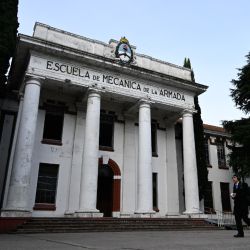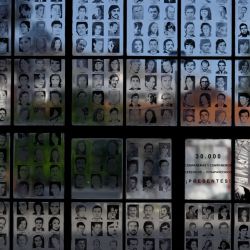The ex-ESMA Navy Mechanics School in Núñez, Buenos Aires, formerly home to a savage detention, torture and extermination camp during Argentina’s brutal military dictatorship (1976-1983), has been added to UNESCO’s prestigious World Heritage List.
The former ESMA, which today is a museum of memory and home to several human rights groups, has been recognised as a site of "outstanding universal value" that belongs to the common heritage of humanity.
UNESCO's World Heritage Committee, which meets once a year, voted to approve ESMA's museum of memory at a meeting in Saudi Arabia.
"The worst of the state terrorism of the last military dictatorship in Argentina was expressed there: detainees, murdered, tortured and disappeared," President Alberto Fernández wrote on the social network X, formerly known as Twitter.
"We continue to keep the memory alive. Nunca más (“Never again"),” declared the head of state.
The UN heritage committee, meeting in Riyadh, welcomed news of ESMA's inscription with applause after an emotional final speech pitching its bid led by Argentina's Ambassador to UNESCO Marcela Losardo.
Afterwards, the audience listened to a video sent by Fernández in which he celebrated the inscription on the occasion of "40 years of democracy" in his country.
"Collective memory is what keeps people from repeating their histories and allows them to move forward towards a better future," he added.
The addition of the site to the UN list is a "great joy,” said Horacio Pietragalla Corti, Argentina’s human rights secretary, who travelled to New York to take part in the sessions.
“This international recognition is a strong response to the discourse that denies or seeks to relativise state terrorism and the crimes of the last civil-military dictatorship," he added.
The ex-ESMA functioned between 1976 and 1983 as a clandestine detention, torture and extermination centre, in addition to its instructional function.
According to the candidacy, submitted in January 2022, some 5,000 of the approximately 30,000 people who disappeared at the hands of the military junta during those years passed through ESMA, making it the largest torture centre of the era.
After the crimes committed on the site became known, and after years of uncertainty about its future, in 2004 the site was turned into the ESMA Memorial Site Museum, a space for denouncing state terrorism in Argentina.
History of the site
In 1924, the Municipality of Buenos Aires ceded 17 hectares to the Navy for the installation of a naval training academy.
The first construction, inaugurated in 1928, was the building known as Cuatro Columnas, located in the Central Pavilion. Between the 1930s and 1950s, two other central buildings were built: the Naval War College and the Officers' Casino.
As the years went by, other buildings were erected all over the site, bringing the total number of buildings to 35. Soon, it was like a small city: there were housing complexes, a shooting range, automotive and electrical workshops, a library, a printing press, a laundry, swimming pool, infirmary, dining halls, a bakery, kitchen, canteen, and, among others, a chapel.
Students at the Navy Mechanics School (ESMA) normally began arriving at around 15 and were trained in one of seven specialities: maritime, electricians, machinists, gunners, communications, supplies and radar technicians.
On November 17, 1972, there was an uprising by members of the Navy who were waiting for a plane to bring Juan Domingo Perón back from exile, though it did not last long as other rebellions failed to follow.
From 1976 onwards, ESMA became a clandestine detention, torture and extermination centre on the orders of the military junta. During the era of state terrorism, approximately 5,000 people passed through its doors, many of whom were disappeared and murdered.
The ‘Officers' Casino’ was the core of the repressive operation, but the entire site and its buildings – including educational institutions – were at the service of the illegal killing machine. The whole structure fulfilled a dual function: as a school and clandestine detention centre.
Following the end of the civil-military dictatorship in 1983, ESMA’s premises continued to serve as a school for non-commissioned officers. But as public knowledge of the crimes committed there grew, society began to wonder what to do with this space.
Faced with a lack of trials for those responsible and government policies of impunity – which included proposals to demolish ESMA and sell off the land to real-estate agents – human rights organisations pushed harder to preserve the site. In 1998, relatives of the disappeared filed a legal appeal with the courts to prevent its destruction.
Finally, on March 24, 2004, the National State stepped in, signing an agreement with the Buenos Aires City Government which ordered the eviction the Navy’s eviction from the site and the creation of the Espacio para la Memoria y para la Promoción y Defensa de los Derechos Humanos (“Space for Memory and for the Promotion and Defence of Human Rights”).
Currently, the site is managed by a public body made up of representatives from the National State, the Autonomous City of Buenos Aires and human rights organisations. Since its recovery, these three actors have proposed a consensual project for the former ‘Officers' Casino.’ In 2013, work began on the preservation and museographic setting of what is now the Museo Sitio de Memoria ESMA, ex Centro Clandestino de Detención, Tortura y Exterminio (“CCDTyE, “ESMA Memory Site Museum, former clandestine centre for detention, torture and extermination”).
– TIMES/AFP/NA
























Comments